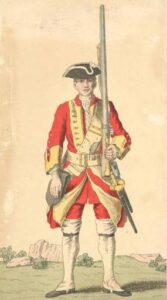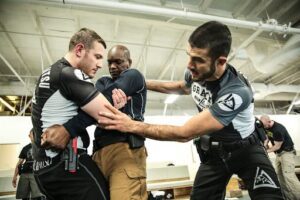
The Boston Massacre and Modern Police Violence

Written by Lou Rocco
The most famous incident of gun violence in American history is undoubtedly the Boston Massacre. But violence perpetrated by the state didn’t end with British rule; we are all too familiar with it in the 21st century. How were the soldiers who perpetrated the Boston Massacre trained to de-escalate conflict? What responsibility do citizens have to make sure their soldiers and police are properly trained to do what society asks of them?
Revolutionary Spaces’ exhibit Training the Force, Then and Now, currently on display at the Old State House, attempts to shed light on these questions.
Bloody Beginnings

On March 5, 1770, British soldiers fired into a crowd of angry Bostonians, killing five and wounding several others. This event would come to be known as the “Boston Massacre.” It was the culmination of a tense, 18-month-long occupation in which British soldiers were tasked with policing the notoriously riotous town of Boston in the wake of tax-related protests.
While it may seem extreme for soldiers to have occupied the town, this was normal for the time and place. Police forces did not exist in the 18th century British world, so soldiers were the default option for quelling riots, rebellions, and other disorders1. Despite being frequently called upon to serve as armed peacekeepers, British soldiers weren’t trained in skills like de-escalation, peer intervention, or crowd control, which help reduce tension and the risk of bloodshed.
Training British Troops
The training of British soldiers in the 18th century was broken into two phases: an introductory or “material” phase and a second, “mechanical” phase. During the “material” phase, recruits were taught the basic skills needed to join and contribute to their units. These skills included simple postures, movements, marching, and firearm training1.
During the secondary “mechanical” phase, new and veteran soldiers alike endlessly drilled the training exercises from the “material” phase. The goal was to make executing basic skills a matter of reflex for soldiers1.
Neither what nor how these soldiers were trained was designed to avoid violence; these soldiers were trained for war, not policing. It is little wonder then that British soldiers often left casualties in their wake when they occupied towns across the British empire, including in Boston.
What Can We Learn?
The Boston Massacre and the inappropriate training that British troops were given to police cities raise intriguing questions. What skills should armed agents of the state be trained in? How much responsibility do they bear if they aren’t trained properly for what society asks of them?
These questions not only apply to British soldiers in the 18th century, but American police today—especially as it pertains to use of excessive and fatal force.
A Problem with Police
There is no national database on police use of excessive force, but newspapers, individuals, and the federal government have been collecting available data on this subject. The data suggest that America has a police violence problem.
Since at least 2015, American police have killed approximately 1,000 civilians per year2. According to the Washington Post’s Fatal Force database, that number reached 1,096 in 2022. The Fatal Force database also suggests that American police shoot and kill people of color at a disproportionate rate. This is especially true of Black Americans, who make up only 13 percent of the national population, but are shot and killed by police at more than twice the rate of white Americans2.
Life Saving Training

Can specialized training help mitigate this phenomenon? Several organizations offer training in a variety of skills designed to reduce the potential for and number of fatal interactions between civilians and police. These organizations have been used by hundreds of police agencies across the country, and their approaches have been proven to reduce the use of fatal and excessive force by police.
These organizations include the Police Executive Research Forum (PERF), which specializes in de-escalation training; Active Bystandership for Law Enforcement (ABLE), which specializes in peer intervention strategies and tactics; and Gracie Survival Tactics (GST), which specializes in defensive, non-fatal tactics.
Revolutionary Spaces’ Training the Force, Then and Now exhibit at the Old State House explores these issues, questions, and solutions in greater detail. Come share your thoughts on training and other reforms for American police before this exhibit closes in March 2023!
Sources:
- J.A. Houlding, Fit for Service: The Training of the British Army, 1715–1795 (Oxford: Clarendon Press, 1981).
- Staff, Washington Post. “Police Shootings Database 2015-2023: Search by Race, Age, Department.” The Washington Post. WP Company, December 5, 2022. https://www.washingtonpost.com/graphics/investigations/police-shootings-database/.

